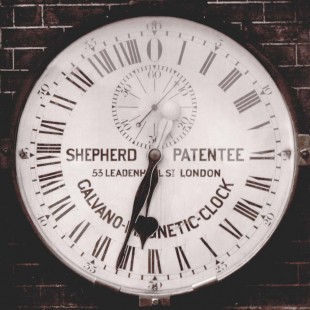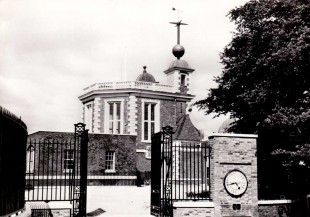…where east meets west
- Home
- Brief History
- The Greenwich Meridian
- Greenwich
(1675–1958) - Herstmonceux
(1948–1990) - Cambridge
(1990–1998) - Outstations (1822–1971)…
- – Chingford (1822–1924)
- – Deal
(1864–1927) - – Abinger
(1923–1957) - – Bristol & Bradford on Avon
(1939–1948) - – Bath
(1939–1949) - – Hartland
(1955–1967) - – Cape of Good Hope
(1959–1971)
- Administration…
- – Funding
- – Governance
- – Inventories
- – Pay
- – Regulations
- – Royal Warrants
- Contemporary Accounts
- People
- Publications
- Science
- Technology
- Telescopes
- Chronometers
- Clocks & Time
- Board of Longitude
- Libraries & Archives
- Visit
- Search
The Shepherd Gate Clock
The Shepherd Gate Clock is mounted on an external wall to the right of the double gates leading into the Observatory Courtyard. Since its original installation in 1852, it has been one of the most photographed objects at the Observatory. It is the public face of Greenwich Mean Time and today serves as a symbol of standardised timekeeping. It is unusual because of its 24 hour dial. Because of its importance, the Clock (together with the wall on which it is mounted), was given a Grade I listing on 8 June 1973.

The Observatory and Gate Clock in about 1870. Although the time shown by the clock is 23.20, it was actually 11.20 in the morning. Until 1885, the Clock displayed astronomical time rather than civil time (see below)
Background to the Clock’s installation

Shepherd's drawing of the mechanism of the slave clock. From Charles Thomlinson's Cyclopaedia of useful arts, mechanical and chemical, manufactures, mining, and engineering, Vol 2 (1854), p.42
A description of the principles behind the clock was published by Charles Thomlinson in Volume 2 of his Cyclopaedia of useful arts, mechanical and chemical, manufactures, mining, and engineering, (1854), pp.41–3.
Friday the 13th ... and the Clock is started
According to the Journal of the Astronomer Royal (RGO6/25), the frame of the Gate Clock was inserted into the wall on 20 May 1852, with the Clock coming into use on Friday 13th August. The cost was £75.
Astronomical, civil and daylight saving time
When originally installed, the Gate Clock displayed astronomical time (which was reckoned from one midday to the next) rather than civil time (which was reckoned from midnight). Following the International Meridian Conference in 1884, the Clock was altered to show civil time with effect from 1 January 1885. Since its inception, the Clock has always shown Greenwich Mean Time, no adjustment ever having been made for it to show daylight saving time (also known as summer time).
A patent dispute and the temporary removal of Shepherd’s name
On June 11, as the Clock was being installed, Alexander Bain (who had invented the first electrical clock in 1840 and taken out a number of patents soon after), called upon Airy to discuss certain patent issues, having taken exception to the fact that the Clock contained Shepherd’s name as patentee. This was followed up by a letter which Airy received and answered on 14 June. After much correspondence with Bain and his solicitor, Airy agreed to remove Shepherd’s name until Bain had legally established his claim. This however was never done: and in 1853 Shepherd’s name was restored.
Repairs in 1881
An entry in Airy’s Journal (RGO6/27) for 25 July 1881 states: ‘The Dial of the entrance gate restored after repair.’ There is no reference to the repair in the Reports to the Board of Visitors, and it is not presently known what this work might have consisted of.
Alterations to the dial in the early 1900s
In about 1910, towards the end of Christie’s term in office as Astronomer Royal, the dial of the Shepherd Gate Clock was repainted. A number of changes were made to both the numbering and fonts, the result of which was a dial with a more clunky appearance. In detail, the changes were:
- A heavier and larger font used for the wording.
- On the minute and the second dials, the numeral 0 at the top replaced by the numeral 60.
- On the same dials, the numerals from 20 to 40 inverted.
- Tram lines introduced around the minute marks to match those on the seconds dial.
- Solid triangular marks introduced at each of the twelve five-minute and five-second marks.
- The abbreviation for Street shortened from Stt to St.
- A hyphen introduced between the words magnetic and clock, presumably to balance the existing hyphen between galvano and magnetic.
Alterations to the solenoids
At some point between the early 1900s and the early 1930s, (possibly in 1927 when a new master clock was brought into use), the number of solenoids in the Clock was reduced from eight to four. The 1911 inventory (RGO39/4/62) states that on 27 April 1922, the coils were rewound, the armature remagnetised and ‘adjustable resistance supplied’. It also states that 15 resistance bobbins (25 ohms each), 8 mounted heat coils and 8 unmounted heat coils (25 amp) were supplied, the order for them having been made on 22 April 1922.

The solenoids as they appeared on 14 March 2007. The brass plate (bottom centre) is engraved with Shepherd's name
War time bomb damage and repairs
On 15 October 1940, the Courtyard gates were destroyed by a direct hit. The wall above the Gate Clock collapsed, and the dial (which was somewhat battered by the blast), bowed outwards. The mechanism itself however was largely undamaged. The site was secured with temporary gates, which were eventually replaced on new piers after the war had ended.
A replica of the dial was made without charge by Messrs. James Cooke and Son, of Stechford, Birmingham. Not realising that the dial had originally been flat, the one they supplied had a domed surface, matching that of the damaged dial which they had been sent to copy. A second dial was made and fitted in 1947. Said by the Astronomer Royal, Spencer Jones, to be an exact copy of the original, the two hyphens in the word galvano-magnetic-clock were in fact omitted. It is not known why this was.
A shuffle to the right
In 1954, as the working Observatory was in the throws of moving to Herstmonceux, the Ministry of Works drew up proposals for the future use of the buildings and grounds at Greenwich. At that time, the plan was to demolish the Gate House (which had been erected in 1890) and realign the boundary on which it stood. During a ministerial visit on 22 April 1958, Hugh Molson (the Minister at the Ministry of Works) indicated that he wanted the Gate House retained. By early 1960, Molson was no longer in office and the plans had changed again. Park Lane in central London was about to be widened. Sections of railings and gates from Hyde Park were about to become available, and the Ministry of Works was keen to use them at Greenwich. This caused a rethink of the boundary treatment. Because the new railings were different in style to those that already existed at the Observatory, it was thought that it would be beneficial from a visual point of view, to demolish the Gate House and erect a new wall on its foundations to carry the Gate Clock – the wall providing a break-point between the two set of railings. In March 1960 a firm decision was taken to demolish the Gate House and carry the plan into effect. As a result, the Clock ended up a few metres to the right of its original position. During the works, the 1934 stainless steel plate showing the Observatory’s height above sea level and the public length standards, (both of which had previously been mounted to the right of the double gates), were relocated to their present position below the Clock.
Repainting of the dial in 1981/2 and a new second hand
By 1981, the paint was blistering badly due to poor original preparation of the copper base and in desperate need of repainting. The bezel, hands, dial and movement were removed on 17 February 1981. The dial was stripped on 8 Sept 1981 and repainted by David Penney. It was reinstalled 19 Feb 1982. Penney’s estimate for work was £150. Early 20th century images and postcards were used as a guide. With the exception of the tram lines around the minute marks, the dial was restored to the appearance it had when first installed in the 1850s.

The dial after the 1981/2 repainting. Note the addition of the tram-lines enclosing the minute marks. Photo taken on 22 September 2014
On 20 August 1982, it was reported that the second hand had ‘broken again’. At this point, a new hand was made by Jonathan Betts.
Master clocks used with the Gate Clock (1852 – present)
The following clocks and electronic systems have been used to control the Gate Clock:
1852–1893 Shepherd Master Clock
1893–1925 Dent No. 2012
1925–1927 ?Dent No. 2012 / Dent No. 2016
1927–1935 ?Short No. 16 via Dent No. 2012 / Dent No. 2016
1935–1939 ?Short No. 49 via Dent No. 2012 / Dent No. 2016
1939–1940 ?
1940–1947 Gate Clock out of service due to wartime damage
1947–1959 ?
1960–1991 Synchronome Pendulum Clock
1991–present Controllers based on MSF signals

The Syncronome Clock in 1990. It was mounted on the east wall of the former clock cellars in Flamsteed House. The pendulum is visible in the glass case on the left. © Douglas Bateman
Acknowledgements
Special thanks to Douglas Bateman who kindly provided the photograph of The Syncronome Clock in 1990 and to Eugen Denkel for drawing attention to the drawing by Shepherd in Thomlinson’s Cyclopaedia of useful arts, mechanical and chemical, manufactures, mining, and engineering.
© 2014 – 2025 Graham Dolan
Except where indicated, all text and images are the copyright of Graham Dolan





